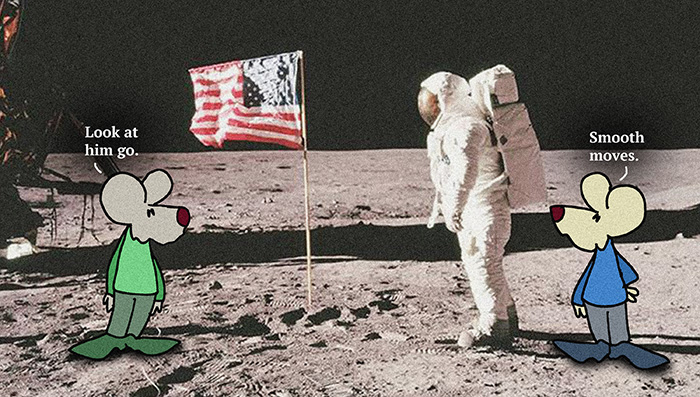Here’s the dish.
Served right up with the spoon.
I remember the first time I saw Michael Jackson do the Moonwalk. It was on some TV event — a Mowtown Anniversary Special. I remember it well. We were all sitting around Patty Bundy and Terri Taylor’s room, watching. We all went crazy, silly college kids that we were. Of course, what ensued was tragic. A bunch of white girls in the 2nd-floor hallway at Schwitzer Hall, trying to do the Moonwalk. We looked less like Michael Jackson, and more like the actual Neil Armstrong taking his first steps in space.
Coincidentally, that happened on this date, July 20, 1969. Unfortunately, I have no recollection of this one. I have other memories of being a five-year-old, but not at 10:56 p.m. EDT on this date. I can’t imagine how American astronaut Neil Armstrong felt, being 240,000 miles from Earth and stepping out of the “safety” of the spacecraft. I’m sure he worked on what he would say long before he went up. Perhaps he was even told what to say. But the words went down in history: “That’s one small step for a man, one giant leap for mankind.”
Stepping off the lunar module Eagle, good old Neil Armstrong became the first human to walk on the surface of the Moon.
What a thing. I mean, we were in stiff competition with the Russians when it came to outer space. The entire effort to send American astronauts to the Moon came from a famous appeal by President John F. Kennedy. It was in 1961 when Kennedy made a pitch to a special joint session of Congress “I believe this nation should commit itself to achieving the goal, before this decade is out, of landing a man on the moon and returning him safely to the Earth.”
At the time, we were still trailing the Soviet Union in space developments. So everyone on the Cold War bandwagon welcomed Kennedy’s bold proposal.
A couple of notable things happened in between Kennedy’s speech and Armstrong’s boot print. In 1966, after five years of work by the National Aeronautics and Space Administration (NASA), we sent up a ship — the first unmanned Apollo mission. But then, just a year later, in 1967, tragedy struck at Cape Canaveral Space Force Station in Cape Canaveral, Florida. That is when a horrible fire broke out during a manned launch-pad test of the Apollo spacecraft and Saturn rocket. Three astronauts were killed in the fire. They were Astronauts Gus Grissom, Ed White, and Roger Chaffee.
Despite the setback, NASA and America pressed on. At first, we sent up manned missions. But then eventually, the landing on the Moon.
As they said. “The Eagle has landed.”
At 10:56 p.m., Armstrong spoke his famous quote. “Buzz” Aldrin joined him on the Moon’s surface at 11:11 p.m. They spent about two hours out there on the Moon, photographing, collecting, exploring. Then, eventually, they came back to Earth. Which is pretty amazing since the Moon orbits Earth at a speed of 2,288 miles per hour. Not to mention that the Earth orbits the Sun at an average speed of 67,000 mph, or 18.5 miles a second. That is some mathematics at work and some skillful navigation, I’d say.
So there it is. The real Moonwalk. The amazing one.
What did we gain from this? Hard to say at this point. But, I imagine when Earth becomes uninhabitable in the near future, a few extremely wealthy Earthlings will probably move to colonies on the Moon. Probably.
As for the rest of us?
Hey, diddle, diddle,
The cat and the fiddle,
The cow jumped over the Moon.
The little dog laughed.
To see such sport,
And the dish ran away with the spoon.
“”””””””””””””””
“You realize that our mistrust of the future makes it hard to give up the past.”
― Chuck Palahniuk, Survivor
“”””””””””””””””
“I know not with what weapons World War III will be fought, but World War IV will be fought with sticks and stones.”
― Albert Einstein
“”””””””””””””””
“Knowing too much of your future is never a good thing.”
― Rick Riordan, The Lightning Thief
“”””””””””””””””
Moving to the groove, thousands of miles away.
